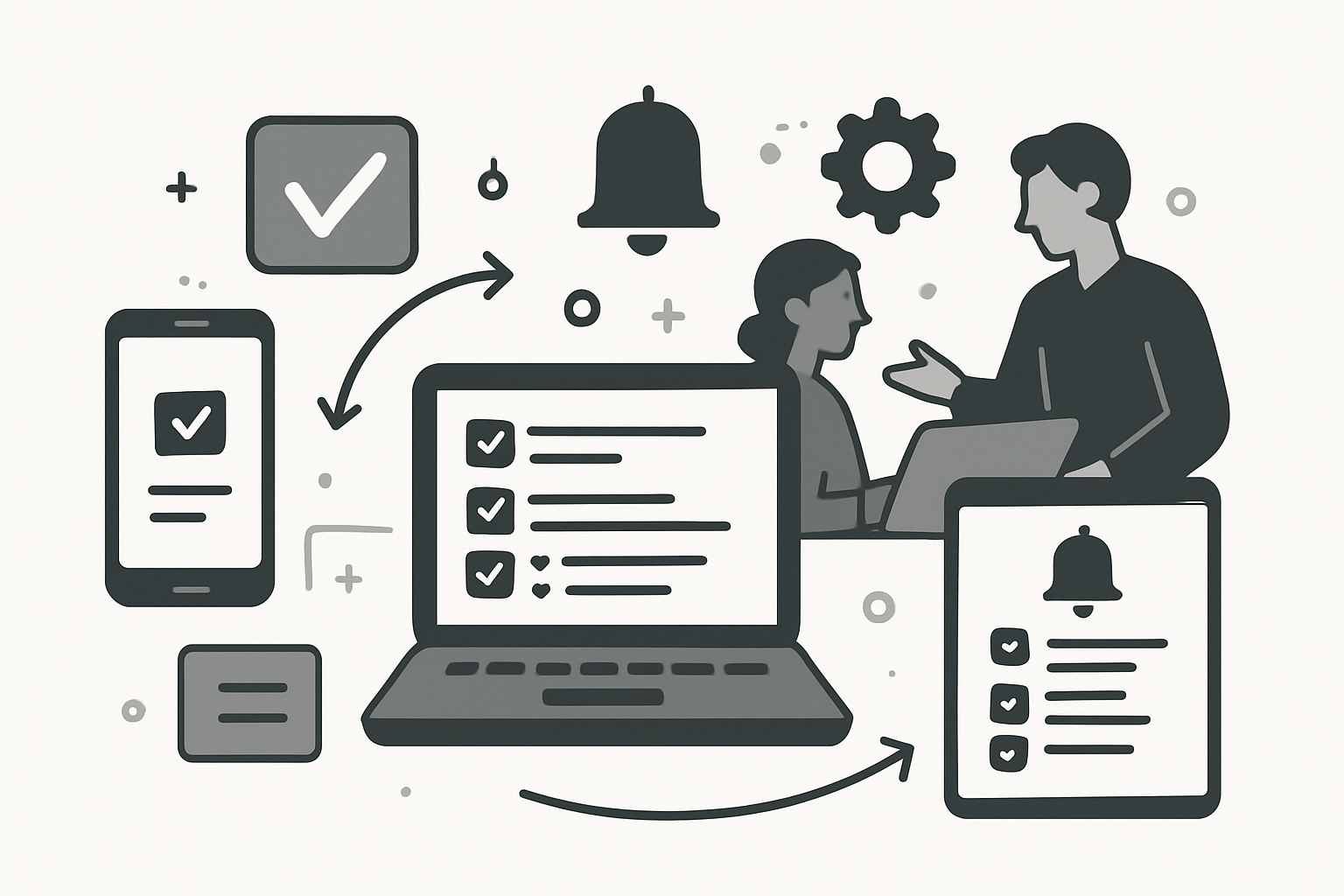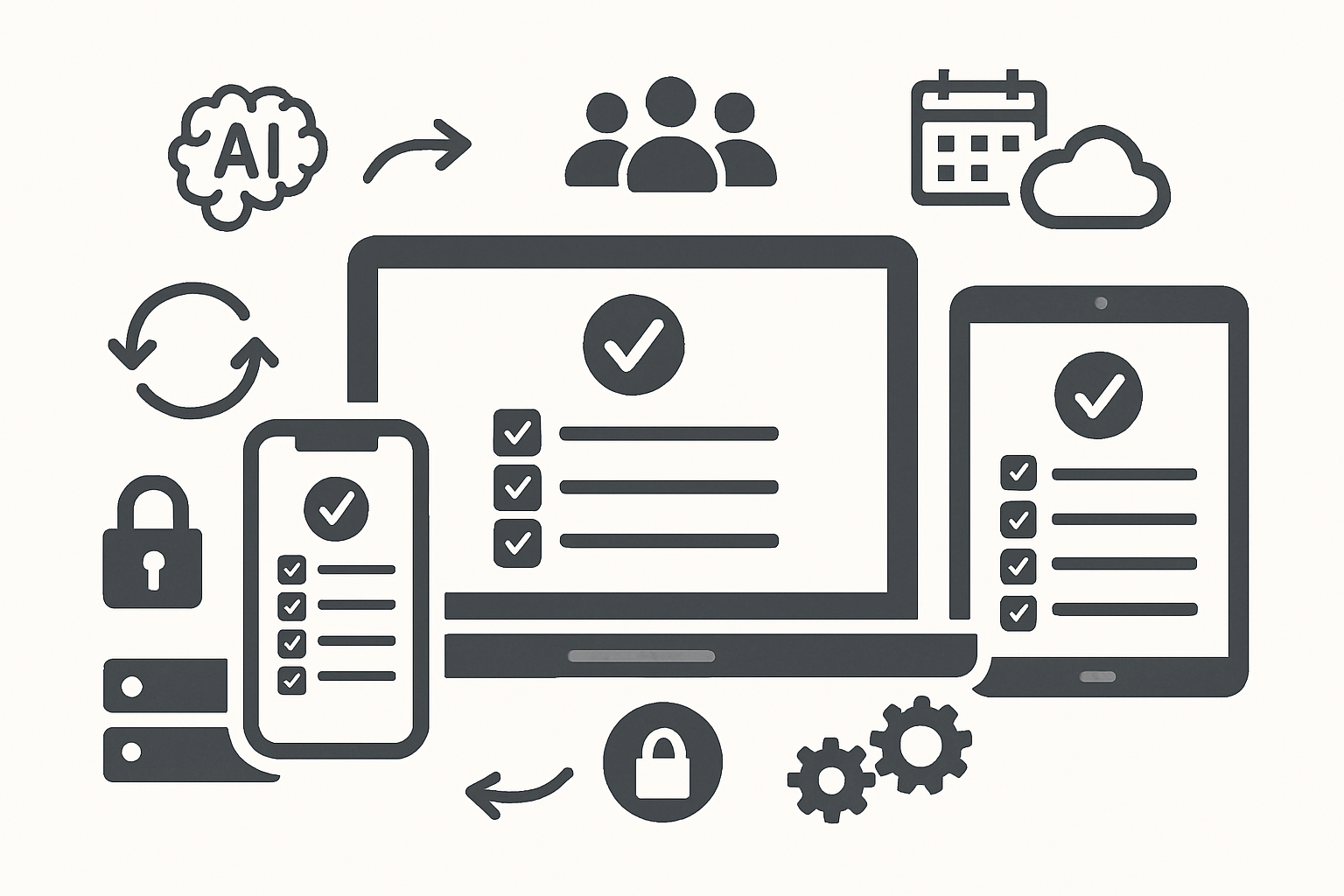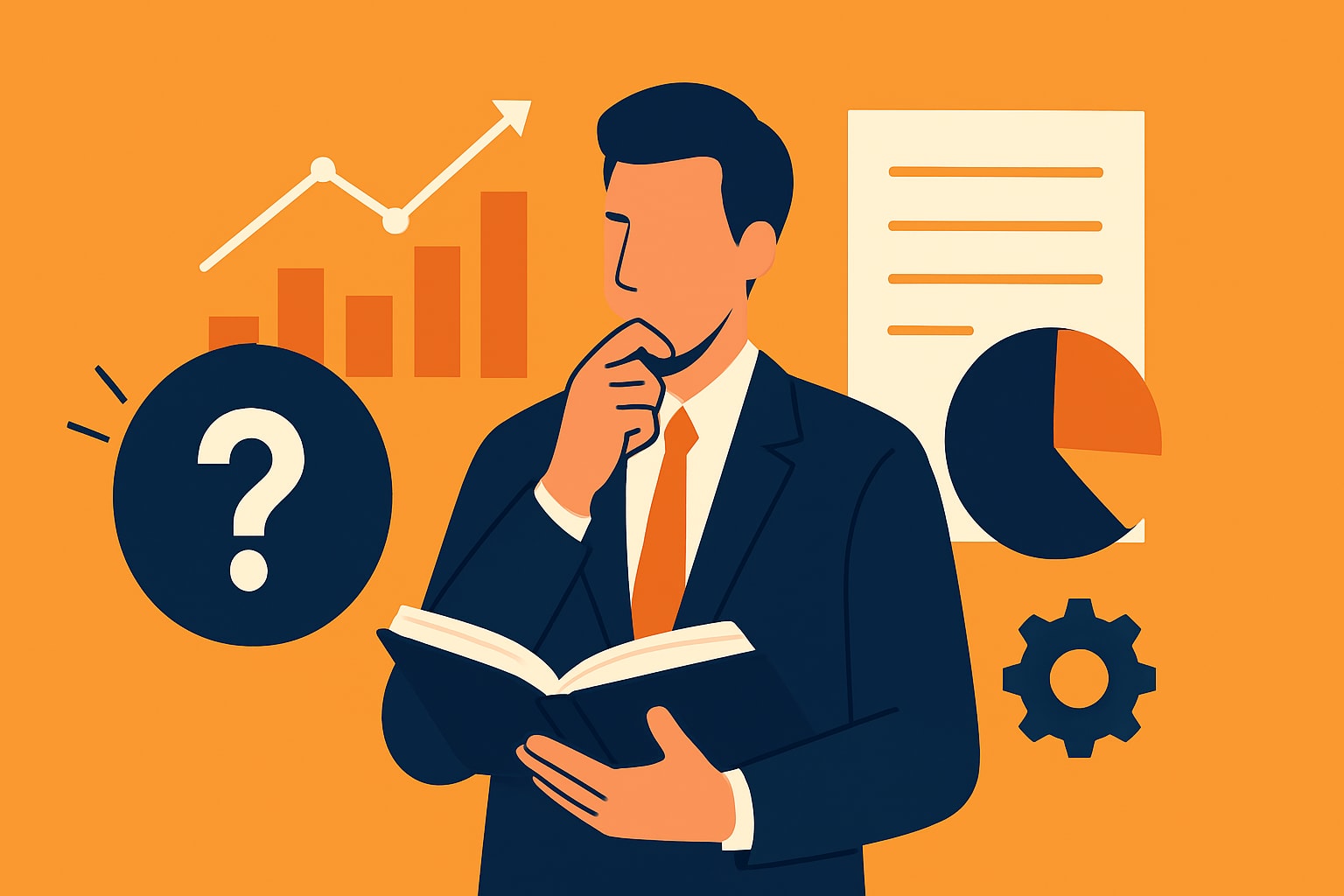Task Management App Guide: Organize Efficiently

In 2025, the complexity of your daily tasks at work and in your private life continues to grow. Traditional to-do lists and sticky notes quickly reach their limits.
The sheer number of projects, appointments, and responsibilities calls for better solutions. A task management app helps you keep an overview, set priorities, and reduce stress.
With efficient digital organization, you not only increase your productivity but also your work-life balance.
In this guide, you'll learn how to take your organization to the next level with modern task management apps. Look forward to selection criteria, top features, step-by-step instructions, and tips on security and data protection.
What is a task management app?
Task organization is becoming increasingly demanding in 2025. Traditional methods like paper lists are no longer enough. Modern solutions like a task management app provide digital structures that bring clarity and efficiency to everyday life.

Definition and basic principles
A task management app is a digital application that helps you capture, prioritize, and manage tasks in a structured way. Unlike classic paper lists or simple sticky notes, these apps enable dynamic adjustments and better visibility.
The goal of a task management app is to consolidate all tasks in one place, set priorities, and make progress visible. Well-known examples include Microsoft To Do, Todoist, and Asana. These tools benefit individuals who want to organize their private or professional tasks, as well as teams working together on projects.
By managing tasks digitally, tasks are no longer forgotten, can be rescheduled more easily, and shared with others. This increases efficiency and brings more structure to everyday life.
Core functions of modern apps
Modern task management app solutions offer a wide range of functions that go far beyond simply writing down tasks. Users can create tasks, sort them by category, and prioritize them individually.
The most important features include:
- Reminders and due dates
- Recurring tasks for regular routines
- Subtasks and checklists for complex projects
- Synchronization across all devices (desktop, smartphone, tablet)
- Collaboration options for teams and families
This turns the task management app into a central tool for productive work and efficient collaboration, whether on the go or in the office.
Why task management is more important than ever in 2025
In 2025, the demands on flexibility and mobility in professional and private life continue to rise. Hybrid work models and distributed teams have become the norm. At the same time, the number of digital tools and interfaces that shape everyday life is growing.
Studies show that the use of modern tools such as a task management app measurably increases productivity. According to Digital transformation boosts productivity, both companies and private individuals benefit from digitizing their workflows.
The right task management app helps you keep track and focus on what matters. It becomes the key to less stress and a better work-life balance.
Common challenges in task organization
Despite digital support, task organization remains a challenge for many. Often there are too many sources of tasks: emails, chat messages, meetings, and private notes. Without a central task management app, a feeling of overwhelm quickly arises.
Typical problems include:
- Lack of an overview of all tasks
- Difficulty prioritizing
- Constant distractions and procrastination
According to a Microsoft survey, 80% of working professionals find managing their tasks challenging. A well-thought-out task management app can help overcome these stumbling blocks and make the workday noticeably easier.
The most important features of a task management app in 2025
Modern requirements demand a task management app that can do much more than just store tasks. In 2025, smart organization is in focus: from AI-driven day planning to cross-device synchronization to comprehensive data protection. Here you’ll learn which features really matter.

Intelligent day planning and prioritization
A 2025 task management app uses artificial intelligence to make your everyday life easier. The "My Day" feature automatically suggests the most important tasks—based on urgency, personal usage patterns, and previous priorities.
This saves you time and lets you focus on the essentials. Personalized recommendations help you organize tasks sensibly. Especially useful is the ability to filter tasks by importance or have them prioritized automatically. This keeps your day clear and you remain in control.
Cross-platform synchronization
Flexibility is essential. A modern task management app synchronizes your data seamlessly between desktop, smartphone, tablet, and web. This means you can capture tasks on the go, continue working on them in the office, and have everything update in real time.
No matter which device you use—all changes are visible immediately. This is especially valuable for hybrid work models, where mobility and home office are becoming increasingly important. You stay productive regardless of time and place.
Team and family features
Together you achieve more. A powerful task management app offers features for teamwork and family organization. You can share task lists, edit them together, and assign tasks specifically.
Transparency is crucial: everyone sees who is working on which task and how far along it is. Whether project management in a company or the shopping list with the family—collaboration features ensure order and clear responsibilities.
Integration with other tools and services
Seamless integration with calendars, email clients, cloud storage, and collaboration tools is a must. A task management app integrates optimally into your existing tool landscape and automates many processes.
With interfaces to services like Outlook, Google Calendar, or Zapier, you can make workflows more efficient. How automation works in practice is explained in the article Automation of task processes. This makes recurring tasks, reminders, and document management second nature.
Security, data protection, and GDPR compliance
Data security is the backbone of any task management app. Especially in a professional context, protecting sensitive information is essential. Modern apps store data in certified data centers and rely on strong encryption.
Two-factor authentication and strict access controls are standard today. Equally important: compliance with the GDPR, so you can work securely and legally. Data protection is not a luxury but a prerequisite for trust and long-term success.
Step by step: Setting up the perfect task management
Do you want to finally bring order to the task chaos with a task management app? With this guide, you’ll get started step by step—whether privately, in a team, or in a company. Each section helps you design your digital task organization sustainably and efficiently.

1. Define goals and requirements
Before choosing a task management app, you should know exactly what you want to achieve. Do you want to structure your personal to-dos, manage projects at work, or distribute tasks in everyday family life?
Consider:
- What goals are you pursuing (e.g., less stress, more productivity)?
- Will you use the app alone, in a team, or with multiple people?
- Do you need specific features such as reminders, calendar integration, or teamwork?
This clarity helps you define requirements and find the right task management app. The more precisely you formulate your needs, the better the later features will fit your everyday life.
2. Choose the right app
Now it’s time to compare. There are many task management app providers—from simple to highly complex, free to paid. Pay attention to the following criteria:
| Criterion | Example |
|---|---|
| User-friendliness | Intuitive interface |
| Platforms | Desktop, mobile, web |
| Price | Free, subscription, one-time purchase |
| Features | Prioritization, lists, teams |
| Data protection | GDPR, server location |
Well-known solutions such as Microsoft To Do, Todoist, Asana, Trello, or TickTick offer different focuses. A comparison helps you find the task management app that suits your requirements and budget.
3. Create task lists and categories
After the selection comes the structure. Create different task lists in your task management app—for example by projects, areas of life, or priorities.
Tips for getting started:
- Create separate lists for work, personal, family, and hobbies.
- Use colors or icons for a quick overview.
- Break down large projects into smaller task packages.
A logical categorization ensures clarity and helps you keep your focus at all times with your task management app.
4. Capture and prioritize tasks efficiently
Now it gets practical: capture tasks as concretely as possible in your task management app. Set clear deadlines, assign priorities, and describe tasks unambiguously.
Helpful methods:
- Eisenhower matrix: urgent vs. important
- ABC analysis: A = very important, B = medium, C = less important
- Getting Things Done (GTD): get tasks out of your head and straight into the app
Many task management app solutions offer templates or automatic suggestions, so you can get started faster and prioritize more efficiently.
5. Reminders, repetitions, and automation
A good task management app reliably reminds you of appointments and recurring tasks. Use push notifications to make sure you don’t forget anything, and set up recurring tasks—like weekly meetings.
Automation brings even more efficiency: connect your app to calendars or email clients. Modern tools like Task management with filehub Workflows even allow you to link tasks with automated workflows—saving time and reducing sources of error.
6. Measure progress and optimize processes
Always keep an overview: many task management app solutions offer statistics, evaluations, and progress bars. Regularly check which tasks are completed and where processes can be improved.
Tips for sustainable success:
- Schedule fixed times for task reviews (e.g., weekly).
- Adjust lists and priorities flexibly to new requirements.
- Use motivators such as ticking off completed tasks or small rewards.
With a consistently optimized task management app, you’ll develop sustainable routines and increase your productivity step by step.
Task management in teams and companies
The modern task management app fundamentally changes teamwork and corporate processes. Efficient collaboration, clear responsibilities, and transparency are the focus. Those who manage teams or entire departments benefit from digital solutions that centralize tasks and projects.
Collaborative task lists and projects
In a task management app, teams can create shared lists for projects or departments. Everyone sees what needs to be done and can assign tasks transparently. Role and permission management ensures that everyone receives the appropriate access rights.
Benefits at a glance:
| Benefit | Description |
|---|---|
| Transparency | All tasks are visible at any time |
| Accountability | Clear assignment fosters engagement |
| Efficiency | Projects run in a more structured way |
With a task management app, even complex projects can be easily managed and progress can be tracked.
Communication and notifications
Successful collaboration thrives on communication. Modern task management app solutions offer in-app comments and notes for each task. This keeps everything in one place—instead of scattered emails.
Automated status updates and reminders keep all team members up to date. Integration with tools like Microsoft Teams or Slack ensures tasks appear right where teams communicate. A task management app thus becomes the central communication hub.
Integration into business processes
A task management app unfolds its potential when it integrates seamlessly into business processes. Connecting with project management, time tracking, or collaboration tools enables automated workflows.
Example: approval processes can be initiated directly in the app. Document management becomes efficient because tasks and files are linked. Companies benefit from clear structures and reduced friction.
Data protection and compliance in the company
Especially in a corporate environment, data protection is indispensable. A task management app should be GDPR-compliant and store data in certified data centers. Access control and logging ensure that sensitive information is only accessible to authorized persons.
Companies rely on solutions that offer transparency and security. The choice of a suitable task management app therefore also depends on compliance requirements.
File automation and task management with filehub
With filehub, the task management app can be optimally extended with automated document workflows. Task management is linked directly to file processes, for example by automatically creating tasks for incoming invoices.

The advantages: time savings, fewer errors, and full GDPR compliance. Companies with high document volumes and strict compliance requirements benefit particularly from this integration. You can find more information on file automation and task management directly at filehub.
Tips & best practices for efficient task management
Efficient task management is no magic trick. With the right strategy and a suitable task management app, you can sustainably increase your productivity. Here you’ll find proven tips to optimize your digital organization and avoid common pitfalls.
The right balance: don’t overload task lists
Less is often more—this also applies to any task management app. Overloaded lists quickly lead to frustration and overwhelm. Set yourself a maximum of three main tasks per day that really count. Break large tasks into smaller, easily achievable steps. This keeps your focus clear and helps you set priorities more consciously.
- Structure tasks by importance.
- Split large projects into manageable subtasks.
- Avoid capturing too many “little things” at once.
A lean list creates more motivation and a real sense of achievement at the end of the day.
Establish routines and daily planning
A task management app only unfolds its full impact through consistent routines. Set your daily list the evening before or in the morning. Schedule fixed time slots to review and adjust your tasks. Use features like the "My Day" view for a clear start.
- Schedule daily review times.
- Automate recurring tasks.
- Reevaluate priorities regularly.
Targeted routines make workflows predictable and create structure in everyday life.
Boost motivation and productivity
Nothing is more motivating than visible progress. Many task management app solutions offer statistics, check-off functions, or small rewards as incentives. Gamification elements like progress bars or points can help you overcome inner resistance.
- Use analytics to track successes.
- Reward yourself for completed tasks.
- Set realistic goals and celebrate small wins.
Also pay attention to data protection when using motivating features. Details on the topic can be found under Security and data protection in task apps.
Limits of task management: when other tools are needed
A task management app isn’t a cure-all. Complex projects with many dependencies or resources are often better managed with specialized project management tools. Calendars, note-taking apps, or time tracking can also be useful additions.
- Recognize when a task list is no longer enough.
- Use project management software for teamwork.
- Integrate calendars and notes for complex workflows.
This way you avoid chaos and find the right tool for each challenge.
Avoid common mistakes
Many users make similar mistakes when using their task management app. Tasks that are too vague, missing deadlines, or juggling too many parallel tools are typical pitfalls.
- Formulate tasks concretely and measurably.
- Set priorities and clear deadlines.
- Keep your tool landscape lean.
Don’t forget to keep an eye on data protection as well. An overview of what to look out for can be found in GDPR compliance for apps.
Security, data protection, and future trends in task management apps
In 2025, the requirements for a task management app go far beyond simple task lists. In addition to efficiency and convenience, security, data protection, and future viability are in focus. Modern solutions must meet technical and legal standards to offer users and companies the highest level of trust and protection.
Current security standards and data protection
A task management app often processes sensitive data. That’s why leading providers rely on encryption, two-factor authentication, and finely graduated access controls. Storing data within the EU, ideally in Germany, is an important criterion for many users.
Transparency about data processing and access rights builds trust. Companies benefit from logging functions that make it possible to trace who accessed which tasks and when. For private users, easy management of permissions is especially important.
- End-to-end encryption for maximum security
- Data centers with certifications (e.g., C5, ISO 27001)
- Regular security updates and audits
GDPR compliance and legal requirements
Compliance with the GDPR is essential for any task management app in Europe. Users should ensure that providers have clear privacy policies and relevant certifications. Companies are obliged to use only solutions that meet compliance requirements.
A current study on automated GDPR compliance evaluation shows how important automated testing mechanisms for apps are. They help developers identify vulnerabilities early and implement data protection requirements efficiently.
Important selection criteria for companies and private users are:
- Location of data storage (preferably EU)
- Verifiable certifications (e.g., C5)
- Clear and transparent privacy policies
Artificial intelligence and automation
In 2025, many task management app offerings come with AI features. Artificial intelligence helps prioritize tasks, analyze usage patterns, and make suggestions. This allows users to continuously improve their way of working and automate routine tasks.
Automated workflows connect task management with other tools such as email, calendar, or project management. Voice control and intelligent notifications are additional features that make everyday life easier. Predictive analytics provides hints about which tasks are particularly urgent.
- AI-based prioritization and day planning
- Automated reminders and workflows
- Integration with third-party applications for seamless processes
Trends 2025: what’s next?
The task management app is evolving rapidly. New working models such as remote and hybrid work require flexible, cross-platform solutions. In the future, task management, calendar, and communication will merge into holistic productivity tools.
Insights into Digital product development 2025 show: adaptive user interfaces, personalized recommendations, and even deeper integration of AI will shape the user experience. The apps will adapt dynamically to individual work styles and team structures.
Expect:
- Even smarter, self-learning task planning
- Deeper integration with collaboration and communication tools
- Focus on user experience and data protection equally
If you now feel like organizing your tasks really efficiently without compromising on data protection or usability, just try it out yourself. With filehub, you can not only maintain task lists, but even automate complex document workflows and store everything securely in Germany. This saves time, reduces errors, and keeps you on top of everything—whether privately or in a company. Put an end to manual processes and discover how easy productive work can be in 2025.
Try filehub.one for free now


